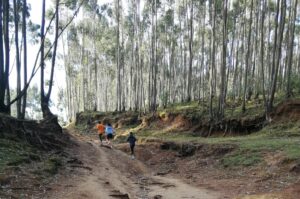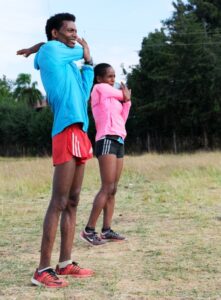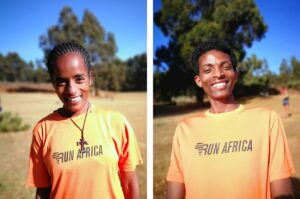Words and Photography by Megan Brownrigg.
“Wear some woolies if you want.”
For a morning run in Ethiopia? Pull the other one.
Come 5am, I hoicked on my bobble hat, microfleece and a scarf. Addis Ababa is fresh before first light. I fumbled for gloves, my eyes seemingly glued together. The low hypnotic hum of the orthodox call to prayer had been my lullaby, along with the ear squeal of a mosquito. And the dog fights, which I’m pretty sure had ended in murder
But to be honest, my overwhelming feeling that morning wasn’t of religion or animal welfare. It was sheer panic. I’m not a runner. And I was about to go for a run 2,600m above sea level. With athletes.
Back in England, I like running in the countryside because no one sees me when I stop. Quite often I’ll claim to be going out for a brisk 10km, and come back two hours later after what has essentially been a walking safari of the Aylesbury Vale. I once committed to training to run 13 miles but, instead of registering for a half-marathon, I did it alone in secret. And did I run the distance without walking? Did I sausage.
Yet here I was, about to embark on a morning run at altitude in Africa.
I’d come to Run Africa as a journalist, having heard it was the only club in Ethiopia offering competitive training for locals and altitude training for tourists. I figured my lack of fluency in PBs or BPMs would be no problem for research. Ed, who helps run the club, had simply said: “Bring your running shoes – no pressure.”
But the way to experience athletics in Addis Ababa is not to sit on the sidelines. Club training happens anywhere from dense forests to mountain meadows. The athletes’ hour comes at dawn, while it’s still cool enough to sprint. Driving to trails, you’ll see silhouettes skulking on hard shoulders. These athletes are hunting the sweet spot between darkness, daylight and heat. But they’re also mastering a delicate science of space. Unlike most cities, the hunt in Addis isn’t for green stretches. The search here is for asphalt.
At sunrise, the chaotic trance of traffic consumes Addis. Cars fatten the air with pollution, swallowing limited oxygen and stealing running routes. The city often reminded me of a film set, where every actor’s movement is implausible. I’d watch people dash in front of a car, certain there would be a collision, only to watch them walk away untouched. It’s a spectacle of sliding doors. But it’s no place to run.
Thanks to altitude, two worlds co-exist in one city. Eucalyptus forests lie just minutes away… exactly where I was headed for my first morning run. I was joining a group of Brazilian amateur athletes in their training for the Great Ethiopian Run.
They were very, very fit. I soon learned that André has run 44 marathons worldwide, including one in the Sahara Desert. He and Danilo are professional coaches who are so good at running, they’re pretty famous on Instagram. That’s how Fernanda and Paula, two women who have perhaps never sweated, met them. Had they not all been lovely, I’d have self-sabotaged my hamstring on the spot.
Our guide for the run, Amanuel (pictured on p109, top right), didn’t help matters. His slender limbs moved imperceptibly as he sprinted over, making willow trees look stumpy. Meanwhile, his lovely warm grin did nothing but worry me. While daydreaming his way, it dawned on me that we hadn’t eaten before the run. Damn. I’d been counting on the placebo effect of some toast for speed and ability. Suddenly Amanuel loped towards the forest and, to my horror, I realised we were supposed to be following him. There was also no warm-up.
I’d later learn that “warm-up” stretches aren’t part of training here. Ethiopians regard it as silly to stretch muscles that are still cold. Instead, they begin by running very slowly. No food, no stretches, no chatter. We ran in silent single-file and somehow, I found myself enjoying it. As day broke, we zig-zagged through tall trees in milky sunshine. We were tracing the forest trails of Millennium Park. This wild sporting ground sits high above the city, but is easily accessible by road. I was told the resident hyenas are no threat to groups… which was motivation to keep pace.
Ed later told me that amateur athletes often feel demoralised on their first run at altitude. At heights surpassing 2,500m on rocky terrain, personal bests fall to pieces fast, which is why they discourage fitness trackers. I for one was relieved we weren’t measuring anything. Apparently even the most competitive Ethiopian athletes don’t measure distance; they just set a time and run. At Run Africa, they advocate training at an RPE: a “rate of perceived exertion” between one and five. That’s as technical as it gets. You’re running by feel.
Towards the end of our run, Amanuel gently ramped up the speed. I suddenly felt my lungs tighten into travel-size versions of themselves. The air thinned and moving got hard. Luckily, this was a sprint finish – the operative word being “finish”. I made it, but wasn’t wild to learn that the introductory run’s RPE was still considered “0”.
Ethiopians might not stretch before a run but boy, do they make up for it after. Dynamic stretches were a shock. Instead of cooling down to a ballad, we went on a cardio dance through the forest. Our arms and legs tangled to Amanuel’s choreography, and our ankles warred with the uneven ground. Switching to static exercises was a real relief.
A simple set of lunges gave me chance to notice our company in the forest. Runners were everywhere, striding in graceful silence. Panting didn’t seem to be a thing in Ethiopia. With a week to go before the Great Ethiopian Run, it seemed that a good chunk of the population was in training… including professional athletes. I was introduced to a woman who’d completed a 64-minute half-marathon and a guy who’d run a full marathon in 2h4m. I was alarmed by how casually these times were dropped into conversation. They were basically world records.
Conscious that my own marathon time doesn’t even exist, I excused myself to a feast of bananas, water and kolo: a local snack made up of roasted grains of barley, sunflower seeds and chickpeas. I ate a field’s worth.
Over the next seven days, I’d have struggled to find a more immersive experience of Ethiopia than running with locals. Not only did we share daybreaks, but long, slow runs would give us a chance to exchange some native Amharic.
I quickly learned the word to cover all sins was “ishī”, meaning OK. I went through about 75 failed pronunciations of “āmeseginalehu” (thank you) before nailing it. I was told where to find the strongest, nuttiest coffee and how to eat injera, traditional fermented flatbread, like a pro. (Rip it, by the way. It’s no tortilla.)
I also learned about the athletes themselves. Zenebach (pictured on p109. top left) fits her running around work as a maid. She admitted the schedule is tough, but she doesn’t consider it a grind: “When you are angry and you run with friends, you forget about it.”
Zenebech was talking to me about anger yet she had about the widest smile I’d seen. She laughed filthily, her eyes creasing up to her braids, when I suggested running is really quite difficult. At the end of training sessions, she’d insist on sharing her bread with me – even if she’d been sprinting intervals and I’d been sat taking photos. And even if she had a shift to get to, she would walk me to the bus station so I could get home. In the throng of commuters, she’d instruct me to carry my rucksack on my front, link my elbow and navigate the jungle of minibuses. When we found ours, we’d join the vehicle’s maximum capacity (plus 25 more people) in a game of human Jenga. Zenebech would pay my fare and refuse a single birr from me. And here she was admitting that she feels anger.
It reminded me that despite her ebullience, this athlete has as many gripes and fears as the rest of us. In truth, she probably has a lot more. But club training gives her somewhere to put them.
She told me: “Running gives me hope. I see it as my future to become an athlete. Which makes me feel like I’m living.”
The club’s symbiosis between international tourists and local athletes also helps people like Zenebech. While I was learning Amharic, she was practising English. For someone aspiring to a sporting career beyond Addis Ababa, that’s a vital skill. What’s more, the Brazilians came generously armed with 80 pairs of trainers, all to be donated to club members, who’d struggle to purchase their own.
Spending time with Zenebech and the others, I was doomed to fall in love with running. But as with any romance, there were fights. My head, heart and lungs unanimously yelled “NO” at the beginning of every run. Danilo, the Brazilian coach, would smile and remind me: “It never gets better. Those first five minutes. They’re always hell.”
So I pushed on. From the meadows of Entoto to steeper scrambles, I joined the Brazilians in their training programme whenever I could. They were so much fitter than me that I was unspeakably grateful for one thing: they were accustomed to treadmills, not trails. Luckily, years of British mud-sloshing and puddle-dodging meant that my hardiness met their fitness somewhere vaguely in the middle. The sensation of oxygen deficiency didn’t disappear, but I found ways to handle it. I bucked the gadgetless trend and wore Bluetooth headphones for one longer run to distract from my heavy breathing. I looked like an alien, but I kept running.
One day I got so keen I thought I’d go on two runs, with a hike in between. By the second run I conceded I’d clearly lost my mind. But outdoors in Ethiopia it’s hard to have a sense-of-humour failure. On another occasion, I kipped on a friend’s sofa so I’d have closer transport links to a 5am run. This was after quite a lot of wine and still I found myself hunkering down into a sleeping bag, excited to wake up in a few hours to exercise. At 3,000m.
On my final run, I was treated to the company of Run Africa founder Rekik. Having gained confidence in my running, I quickly lost it when I discovered her definition of a “slow run”. Putting me through my paces, she asked me to lead the route through Millennium Park. The same spot as my first, terrified, jog. Running behind me, I heard her shout: “Show me your soul!”
I burst into enthusiastic bounds, like an untamed puppy. I finally ran like no one was watching. Mid-performance, I realised Rekik had meant: “Show me your sole.” Oh, God. She just wanted me to lift my feet.
Mortified, I reigned in the theatrics. But I also reasoned, I might have got away with this. My manic cat-leaps had changed my gait effectively: they’d shown off my soles. Never had an existential showcase masqueraded so well as basic technique.
As we piled home for breakfast, I was loath to take my shoes off for the last time. A lot of people in Addis Ababa – amateur athletes, professionals, coaches, taxi drivers – say: “Running is life.” On my first day, I’d had no clue what this meant. I sort of assumed everyone had been brainwashed. But by my last day, I got it. It was by running that I’d got to meet the people, speak the language and feel the verve of Ethiopia.
Running is life here. For some it’s a calling, others a casual hobby and for the lucky few it’s a career. But for absolutely everyone, it’s a community. Whether your soul or your soles, running in Ethiopia gets them showing up.






